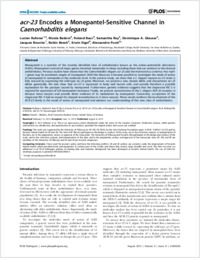Acr-23 encodes a Monepantel-sensitive channel in Caenorhabditis elegans
- Rufener, Lucien Novartis Centre de Recherche Santé Animale, St. Aubin, Switzerland - Institute of Parasitology, McGill University, Ste Anne de Bellevue, Quebec, Canada
- Bedoni, Nicola Department of Biology, University of Fribourg, Switzerland
- Baur, Roland Institute for Biochemistry and Molecular Medicine, University of Bern, Switzerland
- Rey, Samantha Department of Biology, University of Fribourg, Switzerland
- Glauser, Dominique A. Department of Biology, University of Fribourg, Switzerland
- Bouvier, Jacques Novartis Centre de Recherche Santé Animale, St. Aubin, Switzerland
- Beech, Robin Institute of Parasitology, McGill University, Ste Anne de Bellevue, Quebec, Canada
- Sigel, Erwin Institute for Biochemistry and Molecular Medicine, University of Bern, Switzerland
- Puoti, Alessandro Department of Biology, University of Fribourg, Switzerland
-
08.08.2013
Published in:
- PLoS Pathog. - 2013, vol. 9, no. 8, p. e1003524
English
Monepantel is a member of the recently identified class of anthelmintics known as the amino-acetonitrile derivatives (AADs). Monepantel controls all major gastro-intestinal nematodes in sheep including those that are resistant to the classical anthelmintics. Previous studies have shown that the Caenorhabditis elegans acr-23 and the Haemonchus contortus Hco-mptl-1 genes may be prominent targets of monepantel. With this discovery it became possible to investigate the mode of action of monepantel in nematodes at the molecular level. In the present study, we show that a C. elegans mutant acr-23 strain is fully rescued by expressing the wild-type acr-23 gene. Moreover, we present a new mutant allele, and characterize acr-23 alleles genetically. We also show that acr-23 is expressed in body wall muscle cells, and provide therefore a possible explanation for the paralysis caused by monepantel. Furthermore, genetic evidence suggests that the chaperone RIC-3 is required for expression of full monepantel resistance. Finally, we present reconstitution of the C. elegans ACR-23 receptor in Xenopus laevis oocytes and provide direct evidence of its modulation by monepantel. Conversely, co-injection of the chaperone RIC-3 had no impact for channel reconstitution in X. laevis oocytes. These results reinforce the involvement of the ACR-23 family in the mode of action of monepantel and advance our understanding of this new class of anthelmintics.
- Faculty
- Faculté des sciences et de médecine
- Department
- Département de Biologie
- Language
-
- English
- Classification
- Biological sciences
- License
- License undefined
- Identifiers
-
- RERO DOC 32973
- DOI 10.1371/journal.ppat.1003524
- Persistent URL
- https://folia.unifr.ch/unifr/documents/303038
Statistics
Document views: 53
File downloads:
- puo_aem.pdf: 134
